The Starnberger See is the second largest lake in Bavaria (after the Chiemsee) and is situtated to the southwest of Munich. The lake offers spectacular views of the mountains to the south and the proximity to the city has made it a very popular (and very expensive) place to live as well as a popular destination for day trips.
There are a number of towns around the shore - many of them are connected on the regional rail lines from Munich and have further connections through to Mittenwald and Austria or to the Kochelsee.
A popular ferry service links the lakeshore settlements and acts as a magnet for visitors to explore the sights around the lake.
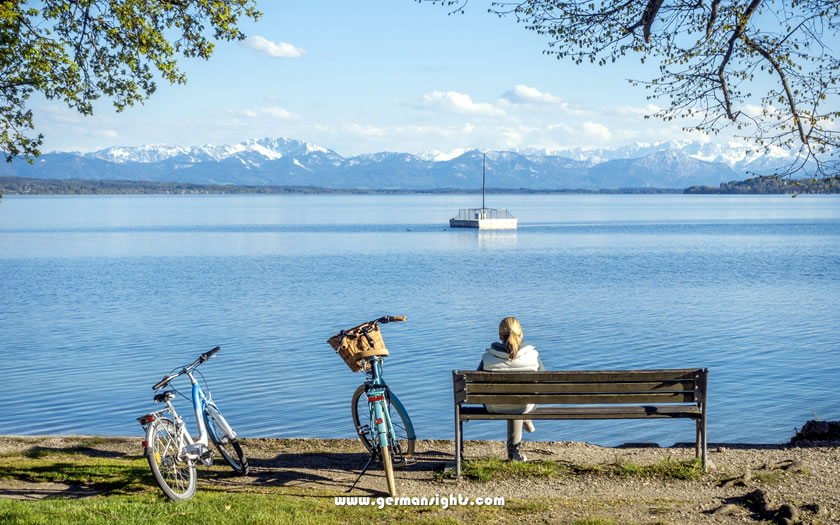
The Starnberger See near Munich with the Alps in the background
The lake was actually formed by the furthest reach of a glacier heading out from the mountains that are visible to the south during the Ice Ages and the hills around it are remnants of the glacial moraines.
It has only been known as the Starnberger See since the 1960s - previously its name was the Würmsee, after the river Würm that feeds it. The local name, the Fürstensee or the Counts' Lake, comes from the lake's popularity amongst the rich and famous.
The Starnberger See is supposed to have one of the highest concentrations of millionaire inhabitants in Germany - and that attraction to the prosperous classes dates back to the Middle Ages when the Wittelsbach ruling family built their residences here.
They used the lake as a summer residence but also for hunting and fishing. In the 17th century a complete fleet was constructed for their entertainment with a three-decked replica of a galley used by the Venetian doges.
The rulers of Bavaria also left a number of the main sights to visit around the lake.
As well as the residence castle in Starnberg, there is the attractive park near Pöcking which are the original grounds of the 'Sissi-Schloss' - Schloss Possenhofen, the castle where Wittelsbach princess Elisabeth grew up in the 19th century. (She was destined to become the notorious Empress Elisabeth of Austria.)
And, on the eastern shore, the sharp-eyed visitor may notice a wooden cross near the shoreline and a memorial set back from the lake at Berg. This commemorates the spot where King Ludwig II of Bavaria met his death in the late 19th century, beset by debts and allegations of a mental breakdown.
The north end at Starnberg and the western side of the lake down to Tutzing are served by regular S-Bahn services from Munich railway station. The line from Tutzing to the Kochelsee also stops at Bernried and Seeshaupt at the southern end of the lake.
Starnberg is only a short drive from the main motorway south from Munich, the A95 in the direction of Garmisch-Partenkirchen and Austria. The distance from the centre of Munich is just under 30km.
If you know when you are planning to go but haven't decided on accommodation, then use the map below to get an idea of what properties are available and to compare prices during the period you wish to travel.
Enter your proposed dates and use the '+' to zoom in on a location and reveal more properties. Click on the price above a property to see more information.
(Please note that this selection will also include some guesthouses, pensions and self-catering apartments for those who are interested in that form of accommodation!)
The ferries around the Starnberger See are operated by the same company, the Bayerische Seenschifffahrt, who run the services on the neighbouring Ammersee, the Tegernsee and the Königssee near Berchtesgaden. They run from Easter through to mid-October.
The lake is split into northern and southern routes. The northern route runs from Starnberg and takes in Possenhofen and Leoni on the western shore and Berg on the east side. The southern route loops between Tutzing and Seeshaupt at the southern end of the lake, stopping at Bernried, Ambach and Ammerland along the way. There is also a Große Schlösserfahrt which is slightly more extensive and takes in some of the castles around the lake.
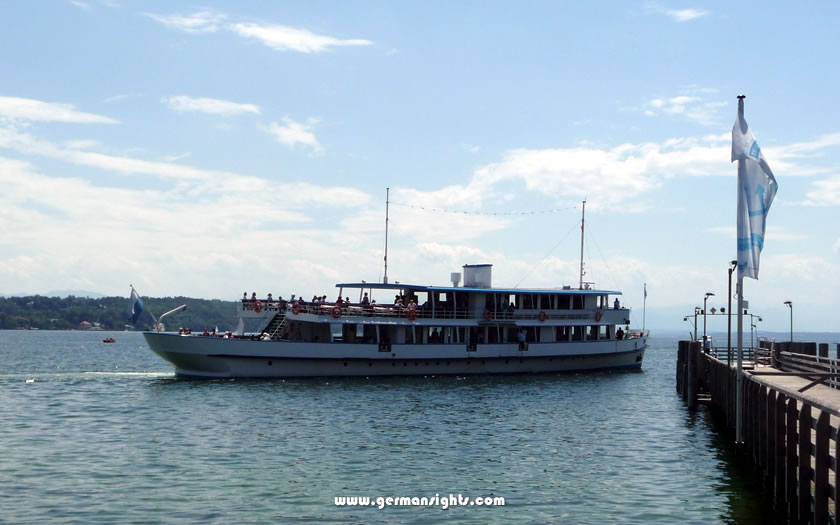
Ferry service on Lake Starnberg
It is possible to do a complete tour of the lake which will take over three hours to complete. The shorter routes allow one break of journey while the complete lake route allows two breaks. There are six ferries in the fleet on the Starnberger See, with the biggest being used on the complete lake tours.
Website: www.seenschifffahrt.de
Originally a small village of fishermen, Starnberg developed into the most important settlement on the lake when the rulers of Bavaria built a residence above the lakeshore. The present-day castle, dating from the 16th century, can still be seen and the gardens visited - the building is now used by the local tax office.
Perhaps that has something to do with the prevalence of well-to-do residents with their lakeside villas and apartments - the percentage of millionaires who live in the community is the highest in Germany.
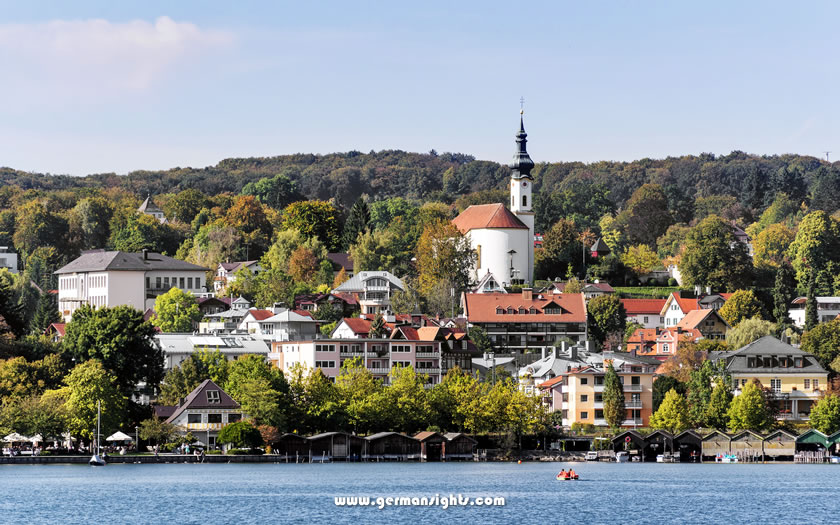
Starnberg on the Starnbergsersee near Munich
There is an attractive lakeside promenade which can be reached under the railway lines and a leaflet describing a cultural walk around the town can be picked up from the local tourist office. There is also a museum about the history of and life around the Starnberger See.
Away from the lake, however, Starnberg is not the most attractive of settlements, with the railway line and the heavy traffic from the motorway splitting different parts of the town from one another.
Tutzing dates back to the eighth century and the name stems from the counts who founded Tegernsee Abbey. Again, originally a small fishing village, Tutzing is known for being the location where politicians discussed the future formation and development of West Germany in the years following the Second World War.
The discussions were held in Schloss Tutzing, a villa which dates back to the end of the 17th century. It is now the Evangelische Akademie Tutzing (the Protestant Academy Tutzing) and is run as a seminar and conference centre.
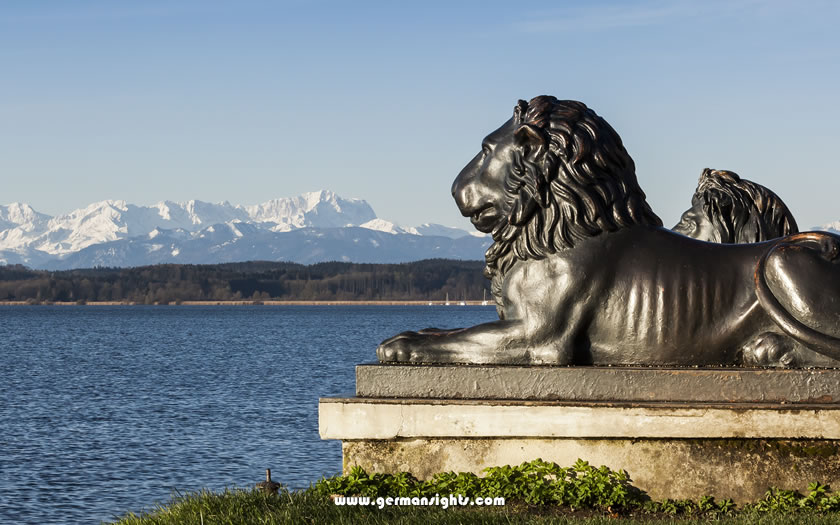
Tutzing, a village in Southern Bavaria on the Starnberger See
With its direct rail connections from Munich and access to services from the south, Tutzing is probably the biggest holiday destination on the lake.
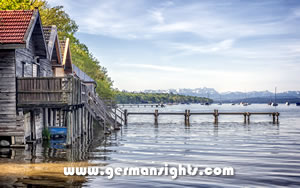
The Ammersee is situated southwest of Munich between the towns of Herrsching and Diessen am Ammersee. The lake is popular with visitors from Munich (it is at the end of a regional train line) and offers a variety of recreational activities, including swimming, boating, fishing, and hiking.
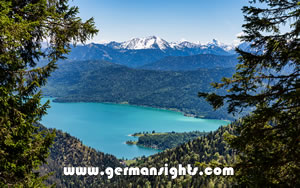
The Walchensee is one of the deepest and largest alpine lakes in Germany. It is located in the middle of the Bavarian Alps, 75 kilometres south of Munich. The lake is a popular destination for swimming, windsurfing, and hiking.